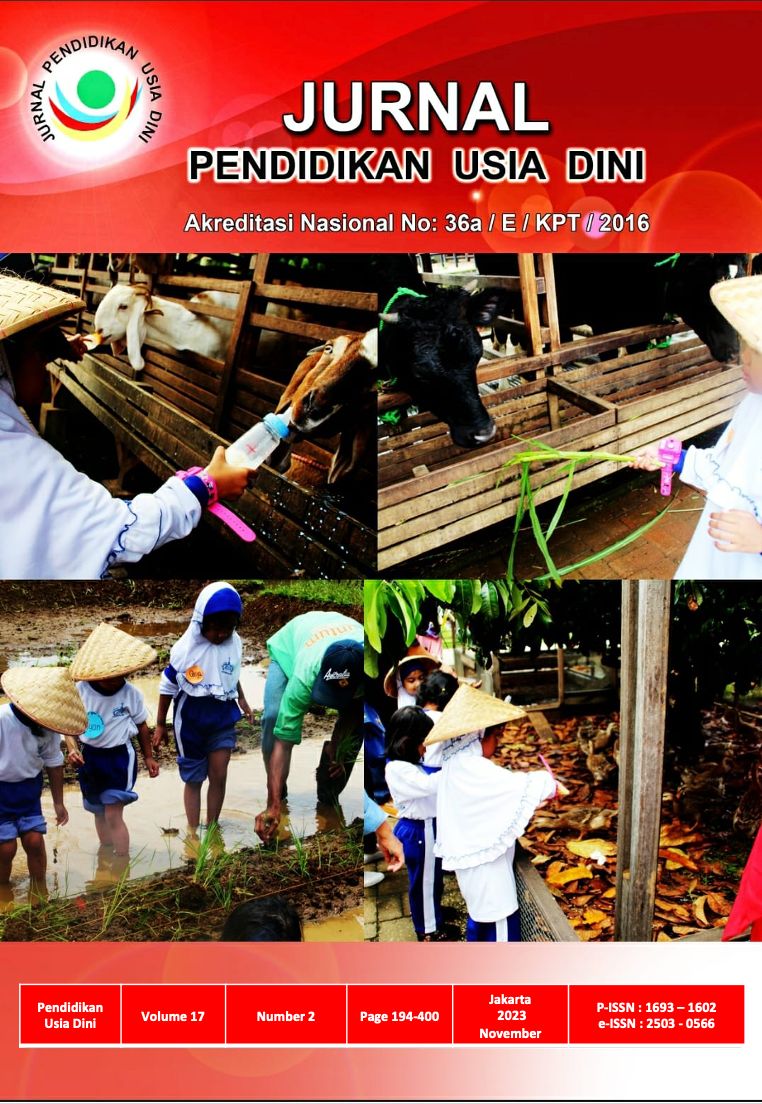Active and Innovative Indonesian Language Learning Model for 8-Year-Old Children
DOI:
https://doi.org/10.21009/JPUD.172.02Abstract
Mastery of Indonesian language skills for children is still a challenge for teachers and parents. Teachers need an effective learning model to improve Indonesian language skills and knowledge. This research aims to develop an active and innovative Indonesian language learning model for children aged 8 years by collaborating with the Numbered Heads Together, Sample Non-Examples, and Guess Words (NET) learning models. This research is a test of the effectiveness of the learning model with a small group trial study carried out at MI Kompa, and a large group trial carried out at MI Adda'wah and MIN I Sukabumi Parungkuda. Data collection techniques were carried out using a mixture of two types of data, qualitative and quantitative. The research results show that the development of the NET learning model in Indonesian language subjects has succeeded in improving children's learning outcomes. Therefore, the results of this study can be used as a starting point for further research. This study has limitations in using descriptive statistical data that do not yet explain the factors that influence the success of the proposed learning model. The results can also provide a basic approach to support further analysis of the impact of using learning strategies in the classroom, both in increasing student and teacher activity.
Keywords: numbered heads together, non-examples, guess the words, Indonesian, eight-year-old children
References:
Bloom, B. S., Krathwohl, D. R., & Masia, B. B. (1984). Bloom taxonomy of educational objectives. In Allyn and Bacon. Pearson Education London.
Burns, M., Pierson, E., & Reddy, S. (2014). Working together: How teachers teach and students learn in collaborative learning environments. International Journal of Instruction, 7(1).
Hidayat, U. S. (2016). Model-Model Pembelajaran Efektif. Bina Mulia Publishing.
Iskatiana, E. (2017). Pengaruh Strategi Pembelajaran Problem Based Learning dan Kooperatif Tipe Number Head Together (NHT) terhadap Hasil Belajar Matematika pada Siswa Kelas V di SD Bangunharjo. Trihayu: Jurnal Pendidikan Ke-SD-An, 4(1).
Kagan, S. (1989). The structural approach to cooperative learning. Educational Leadership, 47(4), 12–15.
Kurniasih, I., & Sani, B. (2015). Ragam pengembangan model pembelajaran untuk peningkatan profesionalitas guru. Jakarta: Kata Pena, 71–72.
Kurniawan, M. I. (2015). Tri pusat pendidikan sebagai sarana pendidikan karakter anak sekolah dasar. PEDAGOGIA: Jurnal Pendidikan, 4(1), 41–49.
Listiadi, A., Sulistyowati, R., & Sakti, N. C. (2019). Improving learning quality through NHT cooperation model in Indonesian vocational schools. KnE Social Sciences, 884–902.
Nursyamsi, S. Y., & Corebima, A. D. (2016). The effect of numbered heads together (NHT) learning strategy on the retention of senior high school students in Muara Badak, East Kalimantan, Indonesia. European Journal of Education Studies.
Rahmawati, I., Shodiqin, A., & Sugiyanti, S. (2018). Efektivitas Model Pembelajaran Numbered Head Together Berbantuan Media Prezi Terhadap Kemampuan Pemecahan Masalah Matematis Siswa Kelas Viii. Senatik 2018.
Saadie, M. (2007). Strategi Pambelajaran Bahasa Indonesia. Jakarta: Unversitas Terbuka.
Santoso, H. (2011). Membangun minat baca anak usia dini melalui penyediaan buku bergambar. Universitas Negeri Malang.
Serdyukov, P. (2017). Innovation in education: what works, what doesn’t, and what to do about it? Journal of Research in Innovative Teaching & Learning, 10(1), 4–33.
Solchan, T. W., Mulyati, Y., Syarif, M., Yunus, M., Werdiningsih, E., & Pramuki, B. E. (2008). Pendidikan Bahasa Indonesia di SD. Jakarta: Universitas Terbuka.
Susanto, H. (2016). Membangun budaya literasi dalam pembelajaran bahasa Indonesia menghadapi era mea. Jurnal Pendidikan Bahasa Dan Sastra Indonesia, 1(1), 12–16.
Zulela, M. S. (2012). Pembelajaran Bahasa Indonesia Apresiasi Sastra di Sekolah Dasar. Bandung: Remaja Rosdakarya.
Downloads
Published
How to Cite
Issue
Section
License
JURNAL PENDIDIKAN USIA DINI work is licensed under a Creative Commons Attribution 4.0 International License. (http://creativecommons.org/licenses/by/4.0/)





